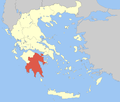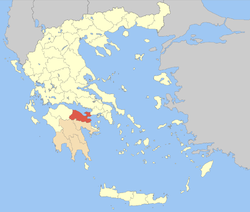- Corinthia
-
Corinthia
Περιφερειακή ενότητα
Κορινθίας— Regional unit — Municipalities of Corinthia Corinthia within Greece Coordinates: 37°55′N 22°45′E / 37.917°N 22.75°ECoordinates: 37°55′N 22°45′E / 37.917°N 22.75°E Country Greece Region Peloponnese Capital Corinth Area - Total 2,290 km2 (884.2 sq mi) Population (2005) - Total 144,527 - Density 63.1/km2 (163.5/sq mi) Postal codes 20x xx Area codes 274x0 ISO 3166 code GR-15 Car plates ΚΡ Corinthia (Greek: Κορινθία, Korinthía) is one of the regional units of Greece. It is part of the region of Peloponnese. It is situated around the city of Corinth, in the north-eastern part of the Peloponnese peninsula.
Contents
Geography
Corinthia borders on Achaea to the west and southwest, the Gulf of Corinth and Attica to the north, the Saronic Gulf to the east, Argolis to the south and Arcadia to the southwest.
The Corinth Canal, carrying ship traffic between the Ionian and the Aegean seas, is about 4 km east of Corinth, cutting through the Isthmus of Corinth. The prefecture is increasingly seen as part of the wider metropolitan area of Athens, with municipalities, such as Agioi Theodoroi in the easternmost part of Corinthia, being considered suburbs of Athens.
The area around Corinth and the western Saronic including the southeastern part are made up of fault lines including the Corinth Fault, the Poseidon Fault and a fault running from Perahcora to Agioi Theodoroi. More faults are near Kiras Vrysi and Sofiko.
The eastern coastlands of Corinthia are made up of pastures and farmlands where olives, grapes, tomatoes and vegetables are cultivated. The rest of Corinthia is mountainous. Its tallest mountain is Kyllini in its west and the largest lake is Lake Stymphalos situated in the southwest. The reservoir will become one of the largest lakes after its completion.
The climate of Corinthia consists of hot summers and mild winters at the coastal areas and somewhat more cold winters with occasional snowfalls at the mountain areas.
Administration
The regional unit Corinthia is subdivided into 6 municipalities. These are (number as in the map in the infobox):[1]
- Corinth (Korinthos, 1)
- Loutraki-Agioi Theodoroi (3)
- Nemea (4)
- Sikyona (6)
- Velo-Vocha (2)
- Xylokastro-Evrostina (5)
Prefecture
As a part of the 2011 Kallikratis government reform, the regional unit Corinthia was created out of the former prefecture Corinthia (Greek: Νομός Κορινθίας). The prefecture had the same territory as the present regional unit. At the same time, the municipalities were reorganised, according to the table below.[1]
New municipality Old municipalities Seat Corinth (Korinthos) Assos-Lechaio Corinth Corinth Saronikos Solygeia Tenea Loutraki-Agioi Theodoroi Agioi Theodoroi Loutraki Loutraki-Perachora Nemea Nemea Nemea Sikyona Feneos Kiato Sikyona Stymfalia Velo-Vocha Velo Zevgolateio Vocha Xylokastro-Evrostina Evrostina Xylokastro Xylokastro Population
Year Population 1991 132,129 2001 144,527 Main towns and cities
The main cities and towns of Corinthia are (ranked by 2001 census population):
- Corinth 29,787
- Loutraki 13,239
- Kiato 9,743
- Agioi Theodoroi 5,960
- Xylokastro 5,618
History
Main article: Corinthia (ancient region)From 1833 to 1899, the prefecture included Argolis and was known as Argolidocorinthia. It included Hydra, Spetses and Kythira. Argolis joined Corinthia to reform Argolidocorinthia again in 1909. Forty years later, in 1949, the prefecture was finally separated from Argolis.
The highway was first paved at the turn of the 20th century. The mid to late-20th century saw the population shifting from agriculture to other jobs, as people migrated to larger towns and cities as well as other parts of the world. In the 1960s, a superhighway was constructed to handle the increasing traffic between Corinth and Athens and allow higher speed limits (60 km/h to 80 km/h). This highway consists of the GR-8A, partly E65 and E94 and is tolled. The section from the old Corinth interchange eastward in Corinthia was opened in 1962 and the section west of Corinthia was added in 1969. The new highway had a significant effect on the prefecture's industry, as it lowered the cost of transportation of goods between Corinthia and the Athens metropolitan area.
In late 2006, the prefect of Corinthia announced the construction of a new dam, to be located 5 to 7 km south of Kiato and Sicyon, near Stimanika, over the Elissos River. It will be the second largest body of water (lakes, reservoirs) in the prefecture and also the first o be built by a prefecture in the Peloponnese. The dam will be designed to withstand earthquakes and natural disasters, including flooding.
On July 17, 2007, a forest fire struck the area around the historic Acrocorinth and its castle.
Economy
The main sources of income are goods and services, manufacturing, tourism and agriculture.
Transport
Below are Coritnhia's road network.
- Motorways:
- Olympia Odos (which integrates Greek National Road 8A)
- Moreas Motorway
- Highways-National Roads:
- Greek National Road 7
- Greek National Road 8
- Greek National Road 66
Communications
- Top Channel - Corinth
Culture
Famous attractions include Ancient Corinth and its acropolis, Acrocorinth, the thermal springs of Loutraki, the Corinth Canal, Nemea and the Heraion of Perachora.
See also
References
External links
- korinthia.net The Ultimate guide for Corinthia
- GTP - Corinthia
- Geomorphological Survey of Eastern Korinthia
- KRRC Geomorphology
- Xenios Magazine articles on Corinthia
- Kiato
Administrative division of the Peloponnese Region  Regional unit of Corinthia
Regional unit of CorinthiaPrefectures of Greece Achaea and Elis (1833) · Achaea (1899) · Adrianople (1920)‡ · Aetolia-Acarnania (1833) · Arcadia (1833) · Argolis and Corinthia (1833) · Argolis (1899) · Argyrokastron (1915)§ · Arta (1882) · Attica and Boeotia (1833) · Attica (1899) · Boeotia (1899) · Chalkidiki (1915) · Chania (1912) · Chios (1915) · Corfu (1864) · Corinthia (1899) · Cyclades (1833) · Dodecanese (1947) · Drama (1915) · Elis (1899) · Euboea (1833) · Evros (1920) · Evrytania (1899) · Florina (1915) · Grevena (1964) · Heraklion (1912) · Imathia (1947) · Ioannina (1915) · Kallipolis (1920)‡ · Karditsa (1899) · Kastoria (1941) · Kavala (1915) · Kefallinia (1864) · Kilkis (1934) · Korytsa (1915)§ · Kozani (1915) · Lacedaemon (1899) · Laconia (1833) · Lakoniki (1899) · Larissa (1882) · Lasithi (1912) · Lefkada (1864) · Lesbos (1915) · Magnesia (1899) · Messenia (1833) · Pella (1930) · Phocis and Locris (1833) · Phocis (1899) · Phthiotis and Phocis (1845) · Phthiotis (1899) · Pieria (1947) · Piraeus (1964) · Preveza (1915) · Rethymno (1912) · Rhaedestos (1920)‡ · Rhodope (1920) · Samos (1915) · Saranta Ekklisies (1920)‡ · Serres (1915) · Sfakia (1912) · Thesprotia (1937) · Thessaloniki (1914) · Trikala (1882) · Trifylia (1899) · Xanthi (1944) · Zakynthos (1864)
From 1971, Attica Prefecture consisted of four prefecture-level units: Athens, East Attica, Piraeus, West Attica
From 1994, the prefectures of Athens and Piraeus; Drama, Kavala and Xanthi; Rhodope and Evros; were grouped intro super-prefecturesdates of first establishment in parentheses
today outside Greece: § in Northern Epirus ‡ in Eastern ThraceCategories:- Corinthia
- Prefectures of Greece
- Regional units of Greece
- 1899 establishments in Greece
Wikimedia Foundation. 2010.


